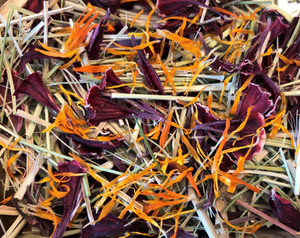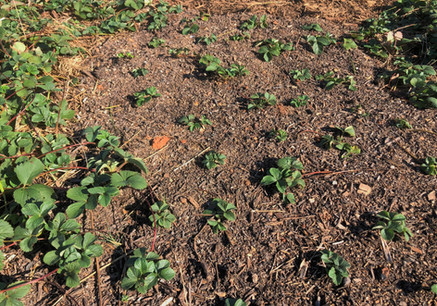October 21- November 10
- Rosa
- Nov 11, 2019
- 6 min read

Luffas at Last
After an entire season of growth, our luffas' time has come. The day before the first heavy frost was destined to hit, we cleared every last gourd from the vines. The night before, a light frost had damaged the leaves, but the fruit were safe. A hard frost, though, would be another story.
Normally, luffas are left on the vine until they are dry and the seeds rattle around in side them. They may be harvested a little earlier if molding is a risk, but though our luffas were large, they were not dry. Luckily, our luffas aren't for eating. They can continue to 'ripen' inside, and will still produce full-sized, exfoliating sponges. When they dry, we'll peel and clean them, but we probably have a few weeks' wait.
Sunchokes from the Earth
A week after that first hard frost, we dug up one of our Jerusalem Artichokes (also known as sunchoke). Helianthus tuberosus is a North American native, which grows up to 9 ft tall and produces stunning banks of small sunflower blooms. Our plants are long done blooming, and the frost has killed most of the raspy green leaves.
Now their treasure lies in the soil. We dug into the dirt around the base of the plant using just our hands and at once found knobbly, white tubers. Moving deeper and closer to the plant, we unearthed more and more, until we pulled the plant sideways and found the mother lode. We never even used a shovel, for fear of slicing one of the tubers.
The main carbohydrate in Jerusalem Artichokes is inulin. When stored for a while or cooked, the inulin converts to fructose. This is unusual among food plants, which deal in starch and sucrose. It lends the sunchokes a sweeter flavor.
Since they are perennial, sunchokes can survive all winter. Apparently, repeated frosts sweeten the tubers. That's part of why we only harvested one plant, but the immediate reason was that our basket was full. We gathered over 17 lbs in just about 10 minutes.
The tubers can be prepared anyway a potato can: roasted, boiled, mashed. Lillian and I sauteed some of the tubers in butter, and solved a mystery. Although they aren't actually artichokes, the cooked tubers taste uncannily like artichoke hearts. This is an absolute delight to know, since artichoke hearts dipped in butter are a delicacy for me and Lilly.
Ever-growing Garden
We've continued to expand the garden beds with new soil and mulch. Much of the land is occupied by chain grass, so we begin by laying down a layer of cardboard as a suppressant. Cardboard takes a little longer to decompose but the grass can grow up through almost a foot of mulch, so the tool matches the foe.
We always mulch completed beds (covered soil is much better than bare soil.) But in the autumn, we get to mulch with leaves instead of hay. Many people graciously donated their yard leaves, so we have an eclectic mixture of oaks and maples and more adorning our garden. Bed building is often arduous, but nothing beats the satisfaction of a fresh swath of garden, all tucked in and ready to go.
Tea Time
We collected the final harvest of hibiscus, lemongrass, and chamomile just before the frosts. We shucked the hibiscus, pared and wreathed the lemongrass, and set aside the chamomile in its dark corner to dry.
I used the already stored and dried plants to mix up little bags of tea. I filled each little bag with enough for at least 3 mugs (but probably way more). The lemongrass, hibiscus, and calendula together made a startlingly colorful mix. As the frosts arrive and the leaves tumble from the trees, the tiny vibrancy of tea is comforting. I finished that evening with a cup of chamomile to round out the relaxation.
Arboreal Birds
Once more, it was time to rotate the chicken yards. This time, both flocks received trees and woody thickets along with a grassy area. The chickens were delighted by this and at once set out turning every leaf they could find. This rotation went the smoothest of any so far. We moved the electric fences and the mobile coops in just a couple hours, and herding the chickens inside was nearly painless. I think they're learning, as are we.
The chicks are almost properly chicken-sized now. Though they still hang out together, they aren't afraid to mingle with the adults. For unknowable reasons, the flock they joined doesn't appear to have a social hierarchy. If it exists, it's subtle. My theory is that none of the chickens can quite be bothered to put in the effort. In any case, the little ones can steal food and forage in the good branches without fear of enforcement.
Final Notes of Fall
Though the nighttime frosts have arrived, the days are still warm. Rain has been more abundant than in the summer, and delicate sprouts and mushrooms have pushed up from the earth. In the fields, the goldenrod and asters have poofed into white seeds.
These few weeks offer opportunities and restrictions alike. The cool, damp weather has relieved some plants of stress, but the approaching coldness nips eagerly at every vulnerable leaf.
Perennial plants that can't withstand winter must be brought into shelter, so we dug up our lemongrass, ginger and ginseng. After a summer of growing, the scraggly lemongrass we began with had multiplied into thick stands. We divided them into clusters and planted them into pots. We brought them into the garage, since we don't yet have a greenhouse. They'll be safe from the frost, and hopefully the roots will survive the cold and provide much more lemongrass next summer.
Seed Saving
I've been sporadically and experimentally collecting seeds from our best plants through the year, and the frosts promised that this was my last collection. I busted up some yellow cherry tomatoes that had remained on our most successful tomato plant, strained the pulp, dried, and packaged them. I also got a handful of lima beans, though most of them didn't reach maturity (and we ate many that did.)
I collected and dried other vegetable and flower seeds, like basil, okra, and sea oats. Come spring, we'll see if my drying and storing produced viable seeds, and learn if it didn't. Seed saving promises a chance to grow a sustainable garden, and I'm hopeful I'll see at least some of this year's plants next spring.
Covers and Cover-cropping
We seeded the old chicken yards and a few bare beds with cover crop, mainly clover and peas, which can withstand frost and fix nitrogen. In the field garden, the transplanted strawberries are doing well, showing almost no signs of shock or stress. I planted them close together so that they can suppress weeds with their own leaves. Weeding them proved difficult this year, and in any case they are largely self-governed beds, more feral than fruitful. Whatever strawberries they produce are flavorful, welcome treats.
The garlic is pushing fat green sprouts up through the hay. There seems to be an almost 100% germination rate, which is exciting. They'll lose the leaves as the winter intensifies, but at least they got a little sun while they could.
We covered the flower seedlings with row covers, a thin, permeable fabric that allows in sun and water but minimizes frost damage. The covers take the edge of for the young flowers as they trudge onwards through winter. When the plants grow tall enough, we'll raise the fabric up onto hoops. The system also protects the succulent sprouts from hungry deer and rabbits, and helps the soil retain a little extra moisture.
Falling Pecans and Flowers
We collected the last of the celosia and the birdhouse gourds. Both harvests will be set to dry; the flowers for bouquets and wreaths, the gourds for birdhouses and other crafts. I'm glad the gourds reached maturity before the frost. We planted them late but they did a fine job.
The most wondrous part of these autumn weeks has been the pecans. I suppose I knew that the big, arching tree watching over the hilltop was a pecan tree, but it didn't really sink in until it began showering the earth with fat pecans. We collect baskets of nuts and crack them one by one. The meat inside is sweet and rich, better by strides than anything in the store. We are very lucky that the tree lives on our land. It may be nearly 100 years old, and might live for hundreds more.










































































































Comments